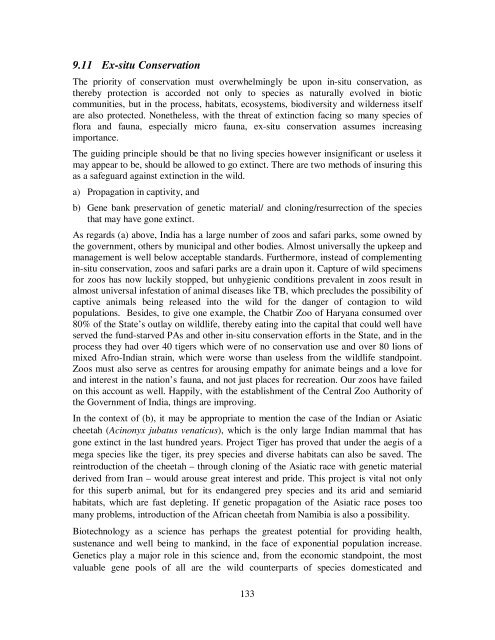Wildlife and Nature Conservation - Centre for Ecological Sciences
Wildlife and Nature Conservation - Centre for Ecological Sciences
Wildlife and Nature Conservation - Centre for Ecological Sciences
You also want an ePaper? Increase the reach of your titles
YUMPU automatically turns print PDFs into web optimized ePapers that Google loves.
9.11 Ex-situ <strong>Conservation</strong>The priority of conservation must overwhelmingly be upon in-situ conservation, asthereby protection is accorded not only to species as naturally evolved in bioticcommunities, but in the process, habitats, ecosystems, biodiversity <strong>and</strong> wilderness itselfare also protected. Nonetheless, with the threat of extinction facing so many species offlora <strong>and</strong> fauna, especially micro fauna, ex-situ conservation assumes increasingimportance.The guiding principle should be that no living species however insignificant or useless itmay appear to be, should be allowed to go extinct. There are two methods of insuring thisas a safeguard against extinction in the wild.a) Propagation in captivity, <strong>and</strong>b) Gene bank preservation of genetic material/ <strong>and</strong> cloning/resurrection of the speciesthat may have gone extinct.As regards (a) above, India has a large number of zoos <strong>and</strong> safari parks, some owned bythe government, others by municipal <strong>and</strong> other bodies. Almost universally the upkeep <strong>and</strong>management is well below acceptable st<strong>and</strong>ards. Furthermore, instead of complementingin-situ conservation, zoos <strong>and</strong> safari parks are a drain upon it. Capture of wild specimens<strong>for</strong> zoos has now luckily stopped, but unhygienic conditions prevalent in zoos result inalmost universal infestation of animal diseases like TB, which precludes the possibility ofcaptive animals being released into the wild <strong>for</strong> the danger of contagion to wildpopulations. Besides, to give one example, the Chatbir Zoo of Haryana consumed over80% of the State’s outlay on wildlife, thereby eating into the capital that could well haveserved the fund-starved PAs <strong>and</strong> other in-situ conservation ef<strong>for</strong>ts in the State, <strong>and</strong> in theprocess they had over 40 tigers which were of no conservation use <strong>and</strong> over 80 lions ofmixed Afro-Indian strain, which were worse than useless from the wildlife st<strong>and</strong>point.Zoos must also serve as centres <strong>for</strong> arousing empathy <strong>for</strong> animate beings <strong>and</strong> a love <strong>for</strong><strong>and</strong> interest in the nation’s fauna, <strong>and</strong> not just places <strong>for</strong> recreation. Our zoos have failedon this account as well. Happily, with the establishment of the Central Zoo Authority ofthe Government of India, things are improving.In the context of (b), it may be appropriate to mention the case of the Indian or Asiaticcheetah (Acinonyx jubatus venaticus), which is the only large Indian mammal that hasgone extinct in the last hundred years. Project Tiger has proved that under the aegis of amega species like the tiger, its prey species <strong>and</strong> diverse habitats can also be saved. Thereintroduction of the cheetah – through cloning of the Asiatic race with genetic materialderived from Iran – would arouse great interest <strong>and</strong> pride. This project is vital not only<strong>for</strong> this superb animal, but <strong>for</strong> its endangered prey species <strong>and</strong> its arid <strong>and</strong> semiaridhabitats, which are fast depleting. If genetic propagation of the Asiatic race poses toomany problems, introduction of the African cheetah from Namibia is also a possibility.Biotechnology as a science has perhaps the greatest potential <strong>for</strong> providing health,sustenance <strong>and</strong> well being to mankind, in the face of exponential population increase.Genetics play a major role in this science <strong>and</strong>, from the economic st<strong>and</strong>point, the mostvaluable gene pools of all are the wild counterparts of species domesticated <strong>and</strong>133
















